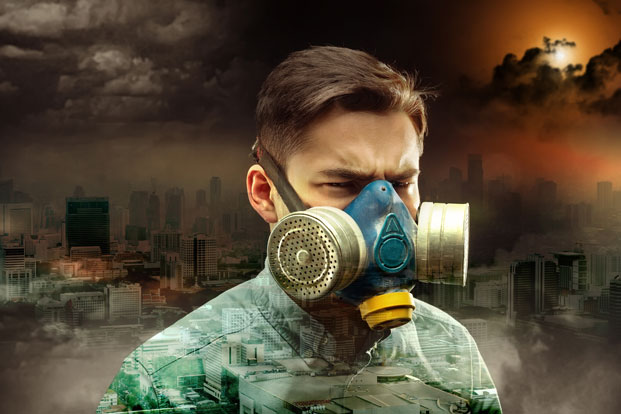If there is any good news about air pollution, it is that the problem used to be far, far worse. In 1970, Congress created the Environment Protection Agency and instituted the Clean Air Act, which gave the federal government authority to move against air polluters. Today, the EPA is the impetus for a number of programs that help reduce air pollution, working in conjunction with states, tribes, industry, local governments and environmental groups.
But all these efforts still do not create pristine air. Polluted air is found indoors and outdoors, and the evidence of its existence can be found everywhere. Buildings, statues, trees, crops and other man-made structures all show wear and tear from polluted air. If you live in a particularly polluted environment, you have the potential to ingest materials that may be harmful to overall health. You may also experience trouble with haze on certain days and get an “air advisory,” which warns that it is not a good idea to exercise outdoors or to let people with existing respiratory conditions exert themselves.
Health Hazards of Pollution
The nose and eyes are common victims of polluted air. Polluted air can irritate the throat and make breathing difficult for those with existing lung problems or particular sensitivities. When airborne particles and ozone get too high, the 30 million United States adults and children with asthma and other breathing issues have problems, and those with heart disease also suffer.
Air pollution comes in many forms and has many components. It can even comprise such toxic chemicals as vinyl chloride and benzene, both found to cause birth defects, cancer, long-term lung injuries, nerve problems and brain damage.
Even when pollution isn’t directly causing human health problems, it can create other troubling issues. Pollution can work to thin the ozone layer, leading to skin cancer and cataract problems, and enough of a buildup can create acid rain and ground-level ozone that damages trees, wildlife, crops and lakes.
Problems Pollution Causes
Here is a rundown of health problems that pollution can exacerbate.
Diagnosing the Effects of Air Pollution
There are treatments to ease air pollution-related suffering and create comfort for those with breathing issues. Doctors will conduct tests to determine a breathing disorder and whether it is caused by pollution.
These tests include:
1) Imaging tests – X-rays may be used but can often be fooled and show normal results. Thus, your medical professional may recommend a CT (computerized tomography) scan.
2) Blood test – These are used to determine lung function.
3) Lung tests – These are a series of hands-on breathing exercises that will help determine the air power of the lungs, measuring their capacity, inflow and outflow, as well as how effectively they deliver oxygen to the bloodstream. Most will be done using a spirometer, which requires a patient to blow into a tube to measure lung function.
Treatment for Air Pollution-Related Diseases
Although many pollution-related diseases cannot be cured, there are some ways to help manage conditions. They include:
1) Bronchodilators. These are drugs that provide relief from coughing fits and can help with breathing issues by relaxing constricted airways. The bigger pathways will lead to better airflow.
2) Inhaled steroids. Aerosolized corticosteroid drugs are inhaled in the same manner as nasal decongestants. They also will relieve shortness of breath but all have side effects, including weakening bones and increasing the risk of developing high blood pressure, diabetes and cataracts.
3) Antibiotics. These are typically used to fight acute bronchitis or pneumonia, which can be a complication of air pollution created conditions.
4) Pulmonary rehab – These are clinical Instructions on ways to cope with shortness of breath. Trained respiratory therapists will show patients breathing exercises and ways to control breathlessness.
5) Oxygen – For end-stage lung problems with extremely low blood oxygen levels, supplementary oxygen may be needed to bring relief. The oxygen is administered with a mask or narrow tubing and may be used constantly in severe cases.
6) Nutrition – Losing weight can ease the burdens on the system. For those in the late stages of certain diseases, there may be a need to gain weight.
7) Surgery – There are some surgical techniques that may ease symptoms of air pollution-created problems. These include lung volume reduction, where small wedges of damaged lung tissue are removed to help remaining lung tissue expand and work better, or a lung transplant, which will remove diseased lungs and replace them with new ones.
Fighting Back
Air pollution is everywhere. And on average, a person breathes in more than 3,000 gallons of air per day, creating plenty of opportunity for exposure to pollution. But there are steps that will reduce exposure time, thereby providing less exposure to irritants.
For someone with existing problems, have someone handle strenuous outdoor chores like lawn mowing, weeding and other gardening. If you do go outside, change clothes after returning and isolate them in a hamper or other container before washing. It is also a good idea to shower away any lingering, clinging pollution or other irritants from skin surfaces.
Finally, consider wearing a dust mask during particularly severe pollution days. Many local weather reports will give an air pollution index, and on high days, it’s time to strap on.

Leave a Reply